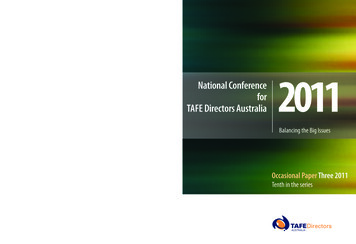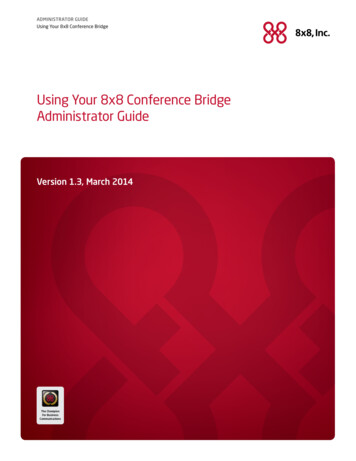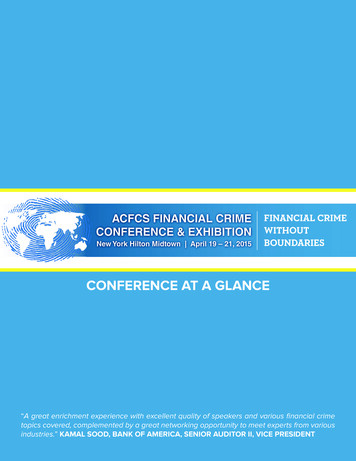
Transcription
Allianz Global Assistance is one of the leadingsuppliers of quality heath cover for internationalstudents. We have been helping internationalstudents for over 11 years through our specialisedproduct—OSHC Worldcare.Our strength is in providing services that aretailored to the needs of international students.Through OSHC Worldcare we provide: on-campus representatives a dedicated website with multilingual content 24 hour, seven days a week assistance line simple no-claim access to doctor networkTo find out more please contact:Brett Slatter – National Business Development Managerbslatter@allianz-assistance.com.au or 07 3305 9825www.oshcworldcare.com.auNational Conference for TAFE Directors Australia 2011 Occasional Paper Three 2011OSHC Worldcare provides peace of mindand help when you need it most.National ConferenceforTAFE Directors Australia2011Balancing the Big IssuesOccasional Paper Three 2011Tenth in the series
Barista Coffee SponsorLanyard SponsorAustralian GovernmentBronze SponsorsOffcial SupportersGala Dinner SponsorsGold SponsorExhibitorsTable DisplaysSilver SponsorMedia PartnersTAFE DIRECTORS AUSTRAIANational SecretariatSydney Institute of TAFE NSWTurner Hall (Building B) – Ultimo CollegeCnr Mary Ann and Harris Streets Ultimo NSW 2007Our Postal AddressTAFE Directors AustraliaNational SecretariatSydney Institute of TAFE NSW Ultimo CollegePO Box 707 Broadway NSW 2007Telephone: 02 9217 3180Facsimile: 02 9281 7335Email:memberservices@tda.edu.auWebsite: www.tda.edu.au
PrefaceThe TAFE Directors Australia 2011 NationalConference, Balancing the Big Issues was held on4–6 September at the Sheraton on the Park, Sydney.The Conference was the most ambitious todate: seventy-three presenters including eleveninternational speakers. There were three hundredand fifty-three delegates, and thirty-five emergingleaders who participated in a professionaldevelopment program over the three days of theConference.The title of this year’s conference, Balancing theBig Issues: TAFE 2011 challenged presenters anddelegates to review the critical issues facingvocational education and training (VET) leadershipin an uncertain environment: industry skills trends ina low carbon economy, a connected tertiary sector,internationalisation, the ‘patchwork economy’,contestable markets and the new regulatoryframework.Conference delegates heard our political leaders,the Minister for Tertiary Education, Skills, Jobs andWorkplace Relations, Senator the Hon. ChristopherEvans MP; the Federal Shadow Minister forEmployment Participation, the Hon. Sussan Ley MP;1and the New South Wales Minister for Education, theHon. Adrian Piccoli MP, outline how they thoughtthe VET sector should be positioning itself torespond to the big issues.Delegates were informed and, at times, provokedby presentations by experts from the United Statesof America (USA) on the implementation of the‘green’ skills agenda, a topical issue for Australiaand by colleagues from the United Kingdom, USAand Canada who provided important insights intothe opportunities and challenges in the provision ofhigher education in further education.The Conference Dinner, a highlight of TAFE DirectorsAustralia (TDA) Conferences, was held this year atone of the world’s iconic venues, the Sydney OperaHouse. This year delegates and guests were bothentertained and informed by presentations fromThérèse Rein, Founder and Managing Director ofIngeus Limited and His Excellency Pedro Pablo Diaz,Ambassador of Chile.Occasional Paper Three 2011 brings together papersand summaries of keynote addresses and panelpresentations. We acknowledge with gratitudethe valuable input of each of our presenters andfacilitators.We very much appreciate the generous support ofour sponsors which, as always, is integral to thesuccess of our conferences.Next year our conference will be held in Perth andwe look forward to your participation in what we areconfident will be another stimulating event.Pam CavenDirector Policy and Stakeholder EngagementNational Secretariat, TAFE Directors AustraliaConference Organiser
2Conference ratings96% rated the Conference as ‘good’, ‘verygood’ or ‘excellent’95% agreed that ‘The discussionscontributed to my understanding of theissues’90% agreed that ‘The Conference deliveredon its aims’Some commonmessagesExcellent use of specific topics, panelpresentations, and focused tablediscussions – much better than longspeeches networking with TAFE sector leadersand emerging leaders; making newcontacts and cementing current onesThe balance of national and internationalviewpointsInsights into broader economic and socialissuesMinisterial addresses – policy level insights– the big picture view!The message of flexibility and the need tocompete in a global marketTAFE in the tertiary sphere – highereducation/degree discussionsOffshore TAFE – sound advice fromexperienced panellists
Welcome3Dear ColleaguesOn behalf of the Board of TAFE Directors Australia, we aredelighted to extend a warm welcome to the 2011 TAFEDirectors Australia Conference hosted this year by TAFENSW.The TDA National Conference 2011, Balancing the BigIssues: TAFE 2011 will review the critical issues facingvocational education and training (VET) leadershipin an uncertain environment: industry skills trends ina low carbon economy, a connected tertiary sector,internationalisation, the ‘patchwork economy’, contestablemarkets and the new regulatory framework.At last year’s conference, Dame Jackie Fisher (NewcastleCollege, UK) challenged delegates to set ambitiousaims and deliver on promises in the face of volatilecircumstances. VET leaders must manage complexand competing demands, and changing industry andgovernment priorities. VET leadership is an act of balance,requiring great skills and a deft touch.TDA is the national peak body representing the interestsof Australia’s 59 publicly funded TAFE institutes. Everyyear, our members provide education and training to over1.7 million Australians seeking new skills and training.The Alumni Gallery at the Conference is testimony to thegreat contribution TAFE graduates make to the Australianeconomy and society.This year we welcome a number of internationaldelegates. We are delighted that we have on theconference program colleagues from government andcommunity organisations in the USA with expertise in theimplementation of the ‘green’ skills agenda. Similarly, wewelcome colleagues from the USA, UK and Canada whoare able to provide invaluable insights into the lessonslearned in their countries from the continuing expansionof higher education in further education.TAFE CEOs havenominated emerging leaders – our TAFE leaders of thefuture. You will get to know them during the course of theConference.Our thanks go to the Conference’s official supporters:TAFE NSW - New South Wales Department of Educationand Communities, and the Department of Education,Employment and Workplace Relations (DEEWR); CISCOas gold sponsor, and Fuji Xerox as a silver sponsor. Wealso thank our other TAFE sector commercial product andservice bronze sponsors and exhibitors for supporting the2011 Conference.We look forward to your contribution to a stimulating,lively consideration of the big issues challenging VETleaders.STEPHEN CONWAY Chair, TAFE Directors AustraliaMARTIN RIORDAN CEO, TAFE Directors Australia
44ContentsPreface – Pam Caven 1Welcome – Stephen Conway and Martin Riordan 3Pre Conference session Sunday 4 September 2011 6Emerging Leaders Forum 6Conference speakers and panellistsMonday 5 September 2011 8Welcome addressesto country by Glenn Doyleto the TDA Conference – Stephen Conway, Chair,TDAby the Hon Adrian Piccoli MP, NSW Minister forEducationPanel session: A balancing act .Strategic directors for VET: radical reform orbusiness as usual? – Robin Shreeve 10Who should drive the VET system: providers orindustry? – Bob Paton 13Contestable funding and uncapped highereducation: clear skies or stormy weather?– David Williams 15TAFE Australia: stitching together the patchworkeconomy – Sue A Slavin 19National Skills Standards CouncilThe Hon John Dawkins AOPanel session: Wealth of resources – orpatchwork economy?Keynote speaker: Keith SpencePanel presenters:The size of the LNG industry – Miranda Taylor 23Where must more be done to meet Australia’sskills needs? – John Coyle 28Structural change or terminal decline?– Dr Phillip Toner 31Global trends in Vocational Education andTraining (VET) – Andrew ThomsonShadow Ministerial addressThe Hon Sussan Ley MP, Federal Shadow Ministerfor Employment Participation 35USA-Australia: sustainability, engagement and‘green’ skills trainingEstablishing the business case for a USA-Australia‘green’ skills learning exchange– Mindy Feldbaum 41Developing the workforce for a sustainable andequitable future – Marcy Drummond 44Technicians in the ‘Green’ economy– Dr V Celeste Carter 47Stream 1: Why should TAFE offer highereducation?Panel presenters:Linda Brown 50Kevin Harris 52Wayne Collyer 55Nicholas Hunt 58Stream 2: Offshore TAFEPanel presenters:Mark Howland 61Marie Hill 64Richard Clifford 68Stream 3: The new regulatory policy landscapeTopic speaker: Dr Dianne Orr 72Panel presenters:Martin RiordanPat Forward 77Conference Gala Dinner 80Conference speakers and panellistsTuesday 6 September 2011 81Welcome Day 2 – Early morning news – how themedia conveys issues of skills and trainingJulie Hare, Annette Blackwell and Peter Mares 81
5Community Colleges’ Baccalaureate Degrees– trends in the United States of America and apractical model for changeDr Barbara J Bryan 83Higher education outside of universitiesTeaching at the VET-HE interface: accounts fromthe US and UK – Assoc. Prof. Leesa Wheelahan 87Ministerial addressSenator the Hon Christopher Evans MP, Ministerfor Tertiary Education, Skills, Jobs and WorkplaceRelations 132Stream 1: What should VET qualifications looklike?Topic speaker: Dr John Buchanan 139International panel:Panel presenters:Higher education in English Further EducationColleges: ‘protect and grow’ – Martin Doel OBE 93Suzy McKenna 142College degrees in British Columbia: successes andchallenges after twenty years– Dr David G Ross 97Broadening the degree granting power of collegesto meet the needs of the new economy– Dr Dan Patterson 100Invitation to the 2012 World Federationof Colleges and Polytechnics (WFCP) WorldCongress, Halifax, Canada – James KnightInternationalisation and a Big Australia:debates on migration, education, populationKeynote speaker: Peter Mares 105High performing institutions: competitors andcollaboratorsPanel presenters:Allan Ballagh 143Rod Cooke 146Stream 2: Unpacking the green skills challengeTopic speaker: Dr Garry McDonald 148Panel presenters:Elizabeth McGregor and Alicia Bales 152Dr Michelle FoxStream 3: Australia’s support for internationalstudentsTopic speaker: Allan Asher 156Panel presenters:Colin Walters 159Diane Seath 162Wesa ChauSurviving and thriving in a tough market –perspectives of a small private provider– Gary Cobbledick 116Stream 4: Symposium– 2011 Emerging Leaders 164How do we balance business imperatives withquality educational programs?– Helen Zimmerman 119Conference Organiser 192UQ College: an initiative at the right time– Rod Arthur 122How do we balance business imperatives withquality educational programs?– Susan Hartigan 125Topical discussion sessions – 1 to 11 128–30Speakers and Panellists – bionotes 166–91Conference MC 192Program at a glance 194Issue number: Three 2011. Tenth in the seriesISSN 1838-0220 (Print) 1838-0522 (Online) Copyright 2011 TAFE Directors AustraliaDesigned by Spincreative 4247 – a proud product of the TAFE system
6Pre Conference sessionSunday 4 September 2011Emerging Leaders ForumEmerging Leaders ProfessionalDevelopment Program
7TDA Chair, Stephen ConwayMinister for Tertiary Education, Jobs, Skills, andWorkplace Relations, Senator the Hon Chris Evans, MPTDA CEO, Martin Riordan, Shadow Minister forEmployment Participation, the Hon Sussan Ley MP,and TDA Chair, Stephen ConwayCampus President, Broward College, Florida, Dr BarbaraBryanChair Mongolian TVET Agency, Mr Byambasuren,Minister Evans, and Chief Executive of HolmesglenInstitute, Bruce MackenzieChilean Ambassador, HE Pedro Pablo Diaz
8Conference speakers and panellistsMonday 5 September 2011Welcome by Stephen Conway, Chair, TAFEDirectors Australia and Managing Director,TAFE SA – Adelaide SouthANDREW THOMSONWelcome to Country by Glenn DoyleMINDY FELDBAUMWelcome address by theHon. Adrian Piccoli MP, NSW Minister forEducationDR MARY SPILDEMC: Ellen FanningTDA Gala Dinner Speakers: Thérèse Rein,Founder and Managing Director of IngeusLimited and His Excellency Pedro Pablo Diaz,Ambassador of ChileROBIN SHREEVEBOB PATONDAVID WILLIAMSSUE SLAVINTHE HON. JOHN DAWKINS AOKEITH SPENCEMIRANDA TAYLORJOHN COYLEDR PHILLIP TONERTHE HON. SUSSAN LEY, MPMARCY DRUMMONDDR MICHELLE FOXDR V CELESTE CARTERLINDA BROWNKEVIN HARRISWAYNE COLLYERNICHOLAS HUNTMARK HOWLANDMARIE HILLRICHARD CLIFFORDDR DIANNE ORRMARTIN RIORDANPAT FORWARD
9Panelsession:A balancing act.PlenarysessionsMC: Ellen FanningThis session introducessome of the big issuesfaced by the VocationalEducation and Training(VET) sector in thenext three years.BradleyBOB PATONCrossDAVIDWILLIAMSSUE SLAVINWhiteTaylor (Lilley)NoonanROBIN SHREEVE
10Strategic directions for VET:radical reform or business asusual?compulsory foundation and trade skills, manyintermediate, technical and managerial occupationspreviously the domain of VET are now beingincreasingly serviced by the university sector. TheBradley Review reforms mean that universities arewell positioned to expand to meet this demand.Without reform, VET, in this growing but changingmarket, risks stagnation.The need for more skills in theAustralian economyRobin ShreeveChief Executive OfficerSkills AustraliaEmail: Robin.Shreeve@SkillsAustralia.gov.auIntroductionOn the basis of their experience over the past twodecades, many in the VET sector would arguethat ‘radical reform’ is ‘business as usual’. VETprofessionals have witnessed the end of TAFE’smonopoly on public funding, the formation of sixtylarge institutes from hundreds of smaller colleges,the rise of competency-based training as well asgovernment’s insistence on industry leadership andgreater efficiency and diversity in providers.With an ageing workforce, reform fatigue is itself anissue for the sector.I will argue that the Australian economy’s need formore skills and the imperative to shift to a moresustainable economy provide great opportunities forthe Tertiary Education Sector in general. However,for the VET sector, there are also significant threats.Whilst VET remains the principal supplier of postThe scenario development and modellingundertaken by Skills Australia indicates that undercurrent economic conditions we will have majorskills shortfalls unless we increase supply (SkillsAustralia 2010, pp. 13–14). This is a significantnational risk. Skills shortages produce wageinflation that leads to general inflation that isnormally corrected by higher interest rates that limiteconomic growth. In current conditions, based on an‘Open Doors’ high growth scenario, Skills Australiaestimates that Australia will need an additional2.3 million people qualified to Certificate III Leveland above by 2015.1 This does not mean there willsimply be an additional 2.3 million new jobs in theworkforce. Rather, it consists of new entrants withhigher qualifications replacing those retiring aswell as existing workers upgrading their skills (skillsdeepening) along with around 800,000 new jobsthat require advanced qualifications.2To satisfy this demand, Skills Australia hasrecommended that we increase tertiary educationenrolments across VET and Higher Education (HE)by around 3% per annum (cumulating) over thenext fifteen years (Skills Australia 2010, p. 9). Asignificant number of jobs will also require theirskills to be deepened, including the ‘green’ skillsnecessary to move to a less carbon emitting
11economy. We also believe that we need to increaseworkforce participation from the current 65% to69% by 2025 (Skills Australia 2010, p. 9) – partiallyto offset the impact of ageing populations – whatBernard Salt has called the ‘baby bust’ that mirrorsthe post war ‘baby boom’.The risks for TAFE institutesNow, all this growth sounds good for TAFE institutes.It could be but there are significant risks that requireurgent attention.Tom Karmel has quantified what many longsuspected – a VET qualification will not get youthe job it got you twenty years ago. Degrees areincreasingly the currency for many future jobs – notTAFE certificates and diplomas (Karmel 2011, p. 2).More worryingly for VET, a recent study based ondata from the Longitudinal Survey of AustralianYouth (LSAY) has concluded that in terms ofpathways for school leavers,.for males two paths stand out:Year 12 followed by university study; andYear 12 followed by an apprenticeship.Apprenticeships and traineeships score wellfor ‘satisfaction with life’. For females, the bestpath is Year 12 followed by university study,and this is true for those with a relatively lowacademic orientation as well as those with ahigh academic orientation (Karmel & Liu 2011,p. 13).One wonders what this means for all those otherVET certificates that are not delivered to young maleapprentices. Qualitative research by Barbara Pocockon low paid workers indicates that a VET credentialhelps older workers get and keep a job. These arepositive attributes but do not necessarily lead tocareer progression (Pocock et al. 2011).This questioning of the value of a VET qualificationis taking place in an environment where the maincompetition – universities – has the uncappedfunding and institutional autonomy to take on TAFEinstitutes.So what can be done?TAFE institutes need to build on the significantreforms of the past twenty years. They have to beseen to be open to change and not be defensiveabout what has yet to be done.They will need a demand-led funding system to beable to compete with the universities, especially inhigher level qualifications. This will require culturalacceptance of ‘income contingent loans’ to enableindividuals as well as government and enterprisesto help fund the expansion of the system. It will alsomean that VET will have to become less opaqueabout performance at the individual provider level.If you give purchasing power to students rather thanbureaucracies, all the evidence suggests studentsneed good information to make informed choices– otherwise competition will be driven mainly byprice. This could drive down quality – another issuein the system.TAFE institutes need the autonomy to offerappropriate qualifications that match workforceneeds and their own institutional capabilities. Thiswill not be easy. They will have to accommodatethe need of their owners – the State and TerritoryGovernments – and come to a lasting settlementwith their staff and staff unions to progress the newagenda.Part of this settlement might include recognitionof the need to invest more in the development oftheir existing staff. But this internal developmentshould not preclude the recruitment of new staff
12with new skills and attitudes to ensure they havethe necessary capacity and capability. I suspectrecruitment is a major issue for TAFE institutes. Thereis a suspicion that some institutes rely too muchon converting existing casual staff into full timeteachers. Many ex casuals become excellent full timeteachers. Institutes who recruit only from this pool,however, risk missing out on highly skilled industryspecialists and industry researchers with veryup-to-date experience who have not got the time toteach part timeOne thing is certain – TAFE has plenty of capabilityto draw on. How it does this, and how it creativelyshapes its own future, are its main challenges.ReferencesKarmel, T 2011, The implication of skills deepening for vocational educationand training in Australia, National Centre for Vocational EducationResearch (NCVER), Adelaide, SA.Karmel, T & Liu, S-H 2011, Which paths work for which young people?,National Centre for Vocational Education Research (NCVER), Adelaide,SA.Pocock, B, Skinner, N, McMahon, C & Pritchard, S 2011, Work, life andVET participation amongst lower-paid workers, National Centre forVocational Education Research (NCVER), Adelaide, SA.Skills Australia 2010, Australian workforce futures: a national workforcedevelopment strategy, Canberra, ACT.Notes1Updated estimates based on Access Economics modelling forAustralian workforce futures.2Updated estimates based on Access Economics modelling forAustralian workforce futures.
Who should drive the VETsystem: providers or industry?13VET as a service industryThe challenge for VET is whether it is a serviceindustry or whether it is shaped for other things. Theimplication that VET institutions are service providersis anathema to some yet if the fundamental premiseof support for industry is accepted, then service iswhat it’s all about. The challenge faced by many VETproviders is to maintain and continue to grow theirestablishment. Growth opportunities may not easilybe found and, in fact, may only present throughactivities that go beyond core business.Bob PatonChief Executive OfficerManufacturing Skills AustraliaEmail: bobpaton@mskills.com.auIndustry leadership in VETIntroductionIndustry leadership has been an underpinning tenetof our VET system for the last twenty years or more.This has been forever challenged and continuesto be reinforced from time to time by both peakindustry bodies as well as governments. However,recent changes are once more threatening theprimacy of industry in determining the purpose andoutcomes of Australia’s VET system.I am using the premise of the VET system beingthere to provide the skilled workers neededby industry to support our economy. The VETsystem also covers a range of other functions, andparticularly those relating to equity in our society.And, yes, we continue to see moves to grow the VETsystem to accommodate aspects of education thatcould be better served by others.If Australia’s current and future workforce is tobe sufficiently productive to ensure success andmaintain our quality of life, the continuing need forgrowth and development of workers is absolutelyessential. Although each enterprise carries a highresponsibility for that growth, there is an expectationthat they will be supported by government-fundedservices, such as education and training expertise,when needed.VET outcomes – is it good for you andgood for me?We all know of the ‘Yes Minister’ hospital where thesmooth functioning was really upset by having todeal with patients. VET providers have made manypositive changes and improvements to how learnersare treated and how their needs are met, yet Icontinue to hear stories of poor service provision byVET providers, both public and private institutions.What needs to occur for the establishment of aculture and practice where a learner is providedwith the best VET services possible for the particularlearner’s needs?If my GP treated me in the same way as some ofthese stories I continue to hear, I’d probably not bearound to write this.
14VET outcomes – what’s best forindustry?The move to an industry-led VET system broughtsevere reaction when it was introduced. Thatreaction continues to roll through the VET system, atthe provider level as well as in other bureaucracies.Despite the revolution of qualifications (whethermodule-based or Training Packages) with a veryhigh degree of inherent variability, many optionsare never realised. It has been said that ‘industry’often doesn’t know what it wants (where ‘industry’ enterprise) and so a fairly standard trainingprogram is offered, mostly at the convenience of theprovider. Although VET is a key part of our existence,most enterprises are more focused on businessperformance, their bottom line and other morepressing matters. If ‘industry’ isn’t offered choices,and extensive ones at that, then ‘industry’ won’tknow what they want because they don’t knowwhat’s available.With trainee and apprenticeship programs, wherethe learner is also an employee, how much effort ismade to engage an employer in some meaningfuldialogue about how progress will be measured anddetermined in terms of workplace performance?VET outcomes – who should determinethe specifications?Industry leadership is determining the outcomeson the basis of our VET system through TrainingPackages. It is acknowledged that accredited coursesalso sit in that space, but these are a minor partof the framework. The abuse of Training Packagequalifications to meet different needs – ones thatwere not included in the fundamental purposeof those qualifications, continues to be a majorconcern of industry. Examples include the provisionof a qualification designed to meet the needs ofa trade apprenticeship to full time learners (bothdomestic and international) and, in fact, grantingqualifications to those learners. We are clearly‘missing the boat’ on this. How can one of theselearners ever be deemed competent when their onlywork experience may be some form of casual oroccasional workplace engagement?
Contestable funding anduncapped higher education15In Victoria we are nine months into a fullycontestable VET market under the Victorian TrainingGuarantee where policy levers determine eligibilityfor government supported places. We are notingsignificant growth in government funded trainingand shifting market share.Uncapped higher education placesDavid WilliamsExecutive DirectorVictorian TAFE AssociationEmail: dwilliams@vta.vic.edu.auIntroductionLast year at the TDA Conference, I addressed a panelsession themed ‘Competitive VET, a case study’.Twelve months on and the significant challenges ofa reforming system are continuing with acceleratingpace and new challenges on the horizon. RobinShreeve has outlined the key challenges in thetertiary space from university providers and I concurwith his views.In the contestable funding market we are seeingsignificant national changes in purchasingarrangements through the National WorkforceDevelopment Fund, transformational changeoccurring in South Australia through the ‘Skills forAll’ policy implementation, and in Queensland,through the ‘Strategic Priorities’ initiativeunderpinned by the Allen Consulting Report‘Queensland Post-Secondary Education and TrainingReview’ and the associated government response.Within twelve months of an entitlement modelbeing implemented in VET in Victoria, there willbe an entitlement model in higher education.Many Victorian TAFE CEOs predict that the fullimplementation of uncapped higher educationplaces will place the ongoing viability of TAFEdiplomas and advanced diplomas at significantrisk. As Robin Shreeve has highlighted today, theresearch of Tom Karmel, (NCVER) in relation to‘Skills Deepening’ options1 supports the views ofmany Victorian TAFE CEOs. They are of the viewthat 2012 will bring, potentially, very significantdeclines in AQF 5 and 6 level TAFE enrolments infavour of higher education enrolments in associatedegrees, diplomas and bachelor offerings. This is,in part, due to the public perception of VET versushigher education qualifications, liberal accessto government funds through CommonwealthSupported Places, universities’ self-accrediting statusand, in Victoria’s case, policy levers that deny accessto government VET funding if higher qualificationsare held. The challenge will be to have competitivelypriced and attractive TAFE options for studentsthrough courses that are clearly distinguishable fromhigher education qualifications or articulate intohigher education.Contestable funding, entitlementcriteria and provider requirementsContestable funding cannot be looked at without
16considering eligibility to government supportedfunding and provider requirements. At the momentwe have a variety of models of entitlement oreligibility.subsidy. Students will also be able to access a oneoff training subsidy to undertake a course at a lowerlevel than their existing qualification, includingthose with a degree or above.Skills Australia propose in the ‘Skills for Prosperity’2roadmap a full public subsidy for those undertakingvocational courses up to and including CertificateIII, and all foundation skills courses. For CertificateIV and above, co-funding between individualsand governments, supported through an incomecontingent loan is proposed.Queensland through the ‘Post-secondary Educationand Training Review’4 has a different model. Itproposes a closer alignment with the Victorianentitlement model with additional featuressuch as capped funding for students with initialqualifications up to degree level, with higher feesto reflect higher individual returns and the capacityof the state to intervene in the market by notfunding or capping specific qualifications in areas ofoversupply or low priority.Currently in three States, we have three variationson the entitlement model either introduced, inprogress towards implementation, or proposed tobe introduced.In Victoria, the entitlement model through theVictorian Training Guarantee provides for agovernment-subsidised place for all people upto the age of 20, and for those over 20 providedthe student is undertaking a course at a higherqualification level than currently held, with theexception of designated foundation courses andapprenticeships. Varying minimum and maximumfees apply to different categories as well as access toVET FEE-Help at diploma and above levels. Studentsundertaking a course at the same or lower level thancurrently held, other than foundation courses, do notattract government support and are required to befull fee paying except for some discrete exemptionsavailable from a limited pool of funds.In South Australia, ‘Skills for All’3 proposes atraining subsidy will be available at the higherlevel up to an advanced diploma. A subsidy at thesame qualification level will be available twice atCert
Sydney Institute of TAFE NSW Turner Hall (Building B) - Ultimo College Cnr Mary Ann and Harris Streets Ultimo NSW 2007 Our Postal Address TAFE Directors Australia National Secretariat Sydney Institute of TAFE NSW Ultimo College PO Box 707 Broadway NSW 2007 Telephone: 02 9217 3180 Facsimile: 02 9281 7335 Email: memberservices@tda.edu.au










